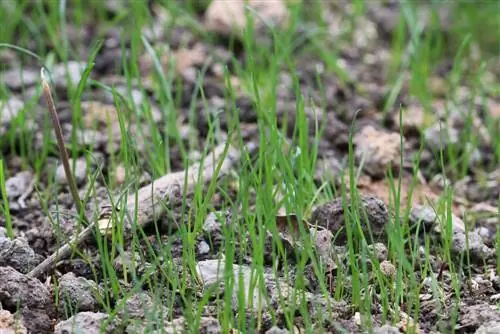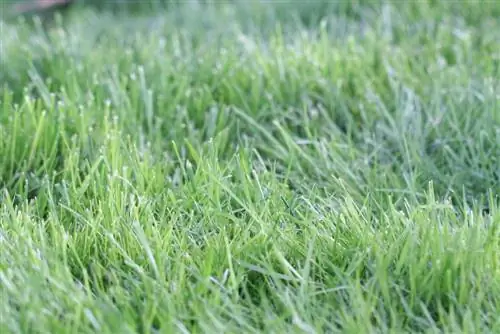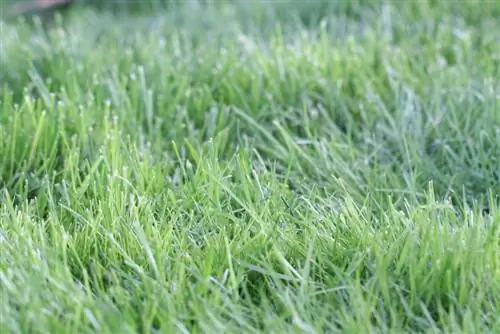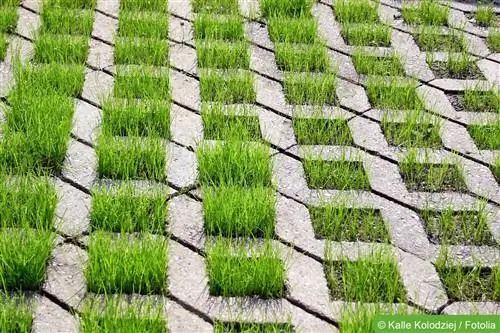- Author admin [email protected].
- Public 2023-12-17 03:39.
- Last modified 2025-01-24 12:45.
It is therefore important not to start mowing too early, otherwise this can damage the lawn! All information can change once a month, depending on the weather in spring.
Preparing lawns in March
After it is already pleasantly warm in March, the lawn should be prepared slowly. Remove all leftover leaves from last fall. The easiest way to do this is with a rake, because there are always damp spots under the leaves. Here the lawn has to dry first. Branches and other hard objects should also be removed. In some areas moles are very active. Here the hills should be trodden flat. In this step, the tunnels and entrances can also be closed with the packed earth. Moss should also be removed in March, because if this is not done, the moss will over time displace the entire lawn. Here you can do two steps at once by using a scarifier. This removes the moss and at the same time the lawn is properly ventilated.
Experts say this is the most important step, especially in March, so that the lawn can grow back vigorously after the winter. This not only removes the moss, but also thatch, dead grass. You shouldn't mow in March because the lawn has to grow back first. After removing moss, we recommend sprinkling lime on top. This prevents new moss from growing back. After liming, the lawn needs to rest for a while before you can continue.
The first lawn cut only in April
- In some places, scarifying can create bare spots. New lawn should be sown here. These then need some time until new lawn grows back.
- The lawn should also be fertilized so that it regains its strength after the winter. Only then can the first cut be made.
- This shouldn't be too short, however. With the first cut, the grass with the natural frost protection is removed and new shoots can grow back.
- The lawn should also be monitored closely so that it may need to be fertilized again at certain intervals. This can be seen when the grass changes color or the amount of grass is reduced.
- You should therefore fertilize regularly from April to August. It's best to always do it before it rains, as this allows the nutrients to reach the soil more quickly.
- From now on the lawn can be mowed at regular intervals, but only by half of the regrown grass.
Caring for the lawn in May
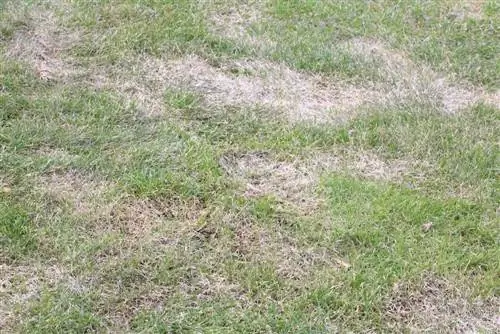
Actually, all steps from March to April can be repeated in May. This also includes scarifying and fertilizing. However, it may also be the case that the lawn needs to be watered now and then. Regular mowing of the lawn is also one of the main tasks in May, as this makes it stronger and stronger. As a rule, mowing can be done every 3 to 5 days. Any weeds that grow should also be removed, preferably regularly. This can then be done by hand as this keeps weeds at bay. To aerate the lawn, you can simply take a rake and simply poke it into the ground at certain intervals. Nothing happens to the lawn; it simply gets better air. If you don't have time to water your lawn all the time, you can get a lawn sprinkler. This also has the advantage that the time and the amount of water can be set precisely. This means the lawn gets enough water, although with a hose this can sometimes be too much.
Lawn care depends on the weather
All the steps that are necessary for a he althy and strong lawn can always be postponed. In March it is often warm enough for the lawn to really sprout. Then the first cut can of course begin this month. It is important that the lawn is never cut too short. The rule always says only half of the regrown stalks. This means the lawn can recover from the winter and grow back vigorously. Of course, all dates will be postponed if the winter simply lasts longer. The most important, first steps are still:
- remove all autumn residue such as leaves and branches
- free the lawn of moss and dead grass, the easiest way is with a scarifier
- Reseeding bald spots
- Always fertilize before the first cut
- the first cut must not be too short so that the lawn can continue to recover from the winter
- Fertilize and water again if necessary
- ensure adequate ventilation
- Mow regularly after the first cut
- Remove the weeds regularly, this can also be done by hand
If you follow these steps, you will have a strong lawn that will soon no longer show winter. It does take a lot of work, but the lush greenery and a thick cover of grass are the reward. A lawn takes a lot of work, but it can also offer a lot in return. But it is always important to do this regularly so that the lawn stays beautiful.
What you need to know about spring lawn care in brief
Proper and continuous lawn care is the basis for strong and he althy growth. Lawn care begins in March to April. Due to the cold season, the lawn is weakened and now needs sufficient nutrients.
Fertilize the lawn
The basic nutrients nitrogen, potassium, phosphorus and magnesium bring the lawn back into shape. Phosphorus supports the sprouting force in spring. Increased moss formation can occur on acidic soils. In this case, the grass is additionally limed once a year. Lime neutralizes the pH value of the soil and counteracts the formation of new moss. Iron sulfate is also an effective moss killer. Iron sulfate is often already contained in lawn fertilizers.
Weed removal
Increased weed growth from dandelions, clover or groundweed indicates that the growth conditions of the lawn are not in balance. Too much moisture, shade and lack of nutrients can be the cause. The weeds can be removed in the long term by frequent but not too short mowing, fertilizing and scarifying.
Tip:
You should avoid removing weeds with herbicides if possible.
Scarify the lawn
Electric scarifiers - devices have rotating blades that remove weeds, thatch and moss with the roots. The soil surface is also loosened, which leads to aeration of the roots. In addition, water and nutrients can penetrate the soil more easily. For this reason, the lawn is fertilized immediately after scarifying. Scarifying and fertilizing takes place in spring and autumn. The lawn is mowed for the first time at the beginning of the growing season when the grass is newly sprouting. Spring cutting should not be shorter than five centimeters so that the grass can regenerate quickly. The shorter the lawn cut, the faster the moss and weeds will grow back.
The lawn is mowed about once a week in dry weather. An ornamental lawn is cut more often than a park lawn or a lawn. Intensive, regular and correct fertilization, mowing and watering ensure a well-maintained, dense and weed-free lawn.

